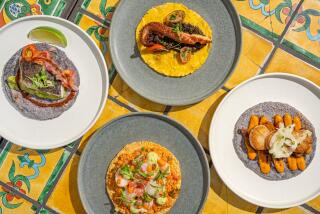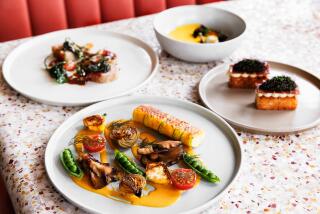Locarno Offers Italian Flavor in a Swiss Village
- Share via
LOCARNO, Switzerland — With the blue waters of Lago Maggiore lapping at its palm-fringed lake front, a Mediterranean climate and the harmony of Italy’s lilting language and hearty food, this Swiss town wears the style of its Latin neighbor.
In Switzerland’s southernmost canton of Ticano adjacent to Italy, Locarno also has a southern Mediterranean heritage. It was a flourishing town during Roman times and became even more prosperous in the Middle Ages with the arrival of the Lombard families. Locarno finally fell to Swiss armies in the 16th Century.
Homes and buildings in the narrow streets of the Old Town were built in the 16th and 17th centuries, and their pastel hues and tile roofs resemble the architectural style found farther south on the shores of Italy’s lake region. That, combined with the 650 types of camellias the city boasts, creates a town that looks more Italian than Swiss.
From the center of Locarno there’s a cog-wheel train up to the Madonna del Sasso basilica. It then climbs to the Cardada Alp, which offers Alpine views, brisk mountain air and winter skiing.
Getting here: Take Swissair’s recently begun nonstop flight to Zurich. American, Pan Am and TWA also will get you here with stops. Then use a Swiss Pass (see below) for a four-hour train ride through the heart of Switzerland to Locarno. Alitalia flies nonstop to Milan, which is less than two hours by car or train from Locarno.
How long/how much? While a full day will let you see most of the town, Locarno is an excellent base for a week of visiting Lugano, Ascona and other towns of Ticino and the Italo-Swiss lake region. Lodging costs are moderate for Switzerland, dining the same.
A few fast facts: The Swiss franc recently sold at 1.65 to the dollar, making it worth about 60 cents. Locarno claims to be the sunniest town in Switzerland, with an average yearly temperature of 60 degrees. May/June and September/October are the best months for a visit, because European visitors create crowds during midsummer.
Getting settled in: Garni Fiorentina (Via St. Antonio 10; $72 B&B; double high season, $66 low) is dead center of Old Town in a quiet pedestrian zone. As the French word garni implies, Fiorentina serves breakfast only, but a restaurant downstairs offers other meals.
This is a little place set above a flowery patio, with contemporary bedrooms that use old and new fabrics imaginatively in the decor.
Hotel Zurigo (lake front, in town; $66 to $107 B&B; double, seasonal) has a small, cluttered lobby, but don’t let that put you off. There’s a good terrace restaurant and sidewalk cafe facing the lake, plus lake front bedrooms with balconies. It’s near the train station, funicular, pier and shopping.
Rosa Seegarten (Viale Verbano 25; $70-$103 B&B; double) also has a lake front terrace restaurant covered with a lush grape arbor and ringed with flowers and tropical plants. Most bedrooms facing the promenade and lake have small balconies with geranium boxes. There’s also a tiny grotto-like bar, and breakfast is a generous buffet. Rosa Seegarten is also central.
Regional food and drink: Locarno’s food has all the zest and exuberance of a Neapolitan tenor. There’s plenty of pasta, hearty sauces, great veal and lots of northern Italy’s polenta.
Trout from the lake and mountain streams, plus egli (a lake fish), are plentiful, as is the local chestnut bread and minestrone ticinese.
Good dining: Trattoria Marcacci (Via Marcacci 9) is in the heart of Old Town in a 450-year-old building. Dining is beneath rustic beamed ceilings inside or on a sunny patio. Try crostini porcini (toasted bread topped with wild mushrooms), gamberoni (prawns) or the risotto porcini (rice with mushrooms). What Marcacci lacks in decor it makes up for in friendliness and good food.
Trattoria da Luigi (Via F. Balli 3) has a marvelous antipasti table within its skylighted indoor room. Seven fresh pastas are served daily and it offers a full menu of interesting Italian dishes.
It’s near the main piazza. Dining is on an outside terrace, beginning always with crostini “on the house.” Owners Jeanette and Luigi Belfiore serve a superb ravioloni di magro al burro e salvia (thin ravioli with butter and fresh sage).
Ristorante la Fiorentina (Via San Antonio 10) has perhaps the finest ambience in town, with a vaulted dining room, a patio with fountain and flowers and views of the mountains behind the town and lake.
There’s a daily menu of Italian specialties (all you can eat) in the $11 range, another for $7.50. Both give you pasta, salad and such main courses as veal scaloppina di tacchino with rosemary. Fiorentina is a real bargain, and the food is excellent.
Going first-class: Grand Hotel Locarno (Via Sempione 7; $96-$120 B&B; double, low season, $114-$138 high) dates from 1876 and has the soaring ceilings, chandeliers, neo-classic columns and faint aura of faded elegance that characterize a grand dame of that era. The dining room has a gigantic fireplace, baroque ceiling painted with a distinct ecclesiastic feel to it and superb food. The shrimp bisque with cognac, panache of gnocchi tessinoise and saddle of veal with mushroom sauce were all outstanding.
There’s also a bar, gardens, pool and tennis courts. Bedrooms are huge.
On your own: After strolling the lake front, take the cog train up to the 15th-Century Madonna del Sasso church, then continue to Cardada Alp for a walk over to the rustic Ristorante Colmanicchio for lunch or a coffee on the terrace while you view the town and lake below.
Back in town, visit the 14th-Century Visconti Castle that houses the town’s Archeological Museum with Roman-era artifacts and later frescoes. Nearby is Casa Rusca, a patrician home converted into an attractive modern-art gallery.
From Modonna del Sasso, a funicular and chairlift takes you to the crest of Cimetta at 5,500 feet where there is a winter Swiss Ski School, restaurant and lodging.
Be sure to visit the 17th-Century nobleman’s home in town with its beautiful garden and chapel, the last built so that the then-Pope would issue a dispensation for the owner to marry his first cousin.
For more information: Call the Swiss National Tourist Office at (415) 362-2260, or write 260 Stockton St., San Francisco 94108 for brochures on Locarno and Ticino with hotel listings, a map of Switzerland and information, plus costs for the Swiss Pass, good on most all types of transportation within the country. Ask for the Locarno package.
More to Read
Sign up for The Wild
We’ll help you find the best places to hike, bike and run, as well as the perfect silent spots for meditation and yoga.
You may occasionally receive promotional content from the Los Angeles Times.






